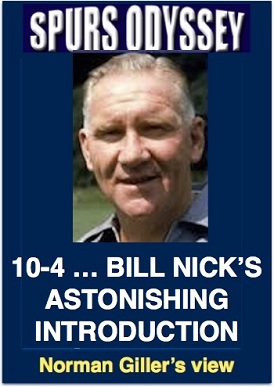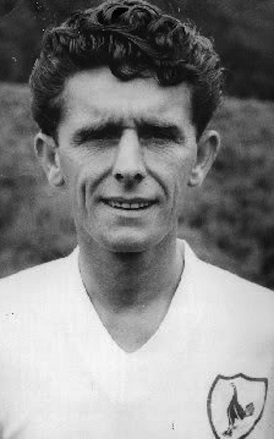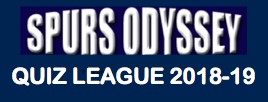|
NORMAN GILLER’S SPURS ODYSSEY BLOG No 247
Submitted by Norman Giller

Just four days ago – on Thursday October 11 – an anniversary passed quietly that deserved to be shouted from the rooftop of the new stadium dominating the N17 skyline. It was sixty years to the day that Bill Nicholson launched his career as Tottenham’s greatest manager with an extraordinary 10-4 victory over Everton at the old (always much-loved) White Hart Lane.
As Spurs prepare to move (at last!) to their new state-of-the-art stadium there are those of us who will be clinging to magical memories of the Lane-that-was; the ground that for 118 years featured some of the finest club football ever witnessed (Here in our Spurs Odyssey home we are allowed to feast on hyperbole).
While waiting for the Tottenham first-team squad to hopefully get through the international break without injury, I am taking time out to revisit what was arguably the most astonishing of all the games that graced the Lane.
On the morning of Saturday October 11 1958 the club announced: “Mr W.E. Nicholson has today been appointed manager of Tottenham Hotspur. He replaces Mr. J. Anderson, who has been suffering from ill health.”
In the afternoon 39-year-old W.E. (Bill) Nicholson was in charge for one of the most remarkable Tottenham matches in history.
Bill Nick (literally a nickname) had been virtually running the playing side of the club as Anderson battled with health issues brought on by the pressures of management. A key player at right-half in the Push and Run team that had won the League championship in 1950-51, Bill joined the White Hart Lane coaching staff after a knee injury forced his retirement.
The quiet, dignified Yorkshireman supervised the Tottenham team during Anderson’s illness while also holding the job of assistant coach to England manager Walter Winterbottom. It was Bill Nick’s clever and suffocating tactics during the summer of 1958 that had earned England a goalless draw against eventual, Pelé-propelled champions Brazil in the World Cup finals in Sweden.
Providing the opposition for his first match officially in charge at the Lane were Everton, struggling three from the bottom of the First Division, a point behind sixteenth-placed Spurs.
The first decision Nicholson made in his new role was to recall Tottenham’s impish inside-forward Tommy Harmer, known to the White Hart Lane fans as ‘Harmer the Charmer.’ But that afternoon Everton found him more like ‘The Harmer’ as he pulled them apart with an astounding individual performance.
He had a hand – or rather a well-directed foot – in nine goals and scored one himself as Everton were sunk without trace under a flood of goals. The final scoreline was 10-4. It might easily have been 15-8!

Tommy Harmer, Tottenham’s idolised ‘Tom Thumb’ character
Harmer was the ‘Tom Thumb’ character of football. A nerves-jangling chain smoker throughout his career, he stood just 5ft 5in tall and was a bantamweight who looked as if he could be blown away by a strong wind. But he had mesmeric control of the ball and when conditions suited him could dominate a match with his passing and dribbling.
Born in Hackney on February 2 1928, he joined Tottenham from amateur club Finchley in 1951 and over the next eight years played 205 League games and scored 47 goals.
For the record, Bill Nicholson’s first selection as Spurs manager (in a 3-2-1-4 formation):
Johnny Hollowbread
Peter Baker John Ryden Mel Hopkins
Danny Blanchflower Jim Iley
Tommy Harmer
Terry Medwin Bobby Smith Alfie Stokes George Robb
There was a hint of what was to come in the opening moments when Spurs took the lead through Alfie Stokes after an inch-perfect diagonal pass from Harmer had split the Everton defence. The Merseysiders steadied themselves and equalised eight minutes later when Jimmy Harris side footed in a Dave Hickson centre.
The unfortunate Albert Dunlop, deputising in goal for injured first-choice ‘keeper Jimmy O’Neill, then suffered a nightmare thirty minutes as Spurs ruthlessly smashed five goals past him through skipper Bobby Smith (2), schoolmaster George Robb, Stokes again and Terry Medwin.
The foundation for all the goals was being laid in midfield where Harmer and Danny Blanchflower, both masters of ball control, were in complete command.
Jimmy Harris gave Everton fleeting hope of a revival with a headed goal to make it 6-2 just after half-time, but bulldozing Bobby Smith took his personal haul to four and the irrepressible Harmer helped himself to a goal that was as spectacular as any scored during this gourmet feast.
Bobby Collins lost possession just outside the penalty area, and the ball bobbled in front of Harmer. He struck it on the half volley from twenty yards and watched almost in disbelief as the ball rocketed into the roof of the net. It was the first time Tommy had scored a League goal from outside the penalty area.
Everton refused to surrender and the industrious Harris completed his hat-trick from a centre by dashing centre-forward Dave Hickson. Then Bobby Collins, just half an inch taller than Harmer, showed that this was a magical match for the wee people when he hammered in a 25-yard drive as both teams crazily pushed everybody forward.
All the goals were scored by forwards until Spurs centre-half John Ryden, limping on the wing in pre-substitute days, scrambled in Tottenham’s tenth goal – the fourteenth of the match – in the closing minutes.
Bill Nicholson, finding it hard to believe what he had witnessed, was close to speechless. It was quite some time later when he told me:
“I have never believed in fairy tales in football, but this came close to making me change my mind. In many ways it was a bad advertisement for football because so many of the goals were the result of slip-shod defensive play. But I have to admit it was magnificent entertainment. Little Tommy Harmer played the game of his life. On his day he was as clever a player as I have ever seen, but he was too often handicapped by his small physique. On this day, he was a giant.”
Everton’s Jimmy Harris commented:
“It was a good news, bad news day for me. I was able to tell people that I had scored a hat-trick against Spurs, and would then mumble the bad news that we had lost 10-4. It’s no exaggeration to say we could have had at least four more goals. I don’t know who were the more bewildered by it all – the players or the spectators, who got tremendous value for their money. Tommy Harmer was the man who won it for Tottenham. It was as if he had the ball on a piece of string.”
Hero Harmer said between cigarette puffs:
“I had been out of the League team for the previous four matches and was half expecting to be left out again when I reported for the match with Everton. But Bill Nick told me I was in, and it became one of those games when just everything went right for me. I particularly remember my goal because it was about the only time I ever scored from that sort of range.”
As Tommy came off the pitch to a standing ovation, he said to Bill Nicholson: “I hope you’re not going to expect ten goals from us every week, Boss!”
It was the peak performance of Harmer’s career. He lost his place in the first-team when John White arrived from Falkirk in 1959, moved on to Watford and then Chelsea, where he earned hero status by scoring the goal that earned promotion back to the First Division in 1963. Joker Tommy said: “The ball went in off my groin. I felt a right knob.”
Still chain smoking, he became a messenger in the City and in later life got lost in the fog of dementia that so many ex-footballers experience. When he passed on at the age of 79 on Christmas Day 2007, Tommy Docherty – his Chelsea manager – said: “He had the best ball control of any English player I’ve ever seen, but very little self belief. If he had been three inches taller and more confident he would have been one of the world’s great schemers.”
Only three players from the Spurs team that scored the knockout ten goals survived as regular members of the Double-winning side of 1960-61– right-back Peter Baker, artistic right-half Danny Blanchflower and biff-banging centre-forward Bobby Smith. The fourteen goals equalled the aggregate First Division record set in 1892 when Aston Villa annihilated Accrington Stanley 12-2.
The attendance was 37,794 … but if you believe everybody who has since said ‘I was there’ it was more like 250,000!
This was just the start. The Glory-Glory days were around the corner.
Now, with the breath-taking new stadium on the horizon, that 10-4 result still sits pleasantly in the memory of Tottenham fans of a certain age, and we quietly smile when we recall the part Harmer the Charmer played in the goals banquet.
Can Harry Kane and Co ever match it? That would really take us down Memory Lane.
And surely Tottenham fans will be cheering on the team from the aptly named The Bill Nicholson Stand. Lay odds on it of 10-4!

Question No 9 in this 2018-19 SOQL season:
Who was the first major signing for Tottenham by André Villas-Boas, and through which English academy did he come before joining a club in the Bundesliga?
Please email your answer to me at SOQL9@normangillerbooks.com. Deadline: midnight this Friday. I will respond to all who take part.
This year’s prizes for the champion: two books from my Spurs collection with autographs from Jimmy Greaves, Steve Perryman and Dave Mackay, and a framed certificate announcing the winner as SOQL champion.
There will also be a special bonus prize that I will announce later in the season. I promise it’s a collector’s item for anybody who follows the mighty Spurs.
Last week I asked: Which Tottenham-born winger was in two winning Spurs League Cup winning squads, and against which team did he appear at Wembley in the year he had to retire from football with an injury?
Some of you got your Jimmys mixed up and answered Jimmy Neighbour, but the man I was looking for was Jimmy Pearce, sadly forced to retire at the end of the 1973 year when at the peak of his career. He was in the squad for the 1971 League Cup victory over Aston Villa and played in the 1973 League Cup final against Norwich City, when Ralph ‘Combover’ Coates came on as a substitute and scored the only goal of the match.
Please keep a check on your scores. I will be trusting you to count your points as I do not have faith in my email server.
Thank you for taking part. See you back here same time, same place next week. Keep the faith. COYS!
The "Giller Index" - listing all Norman's articles for Spurs Odyssey
Top of page | Spurs Odyssey Home Page
|

